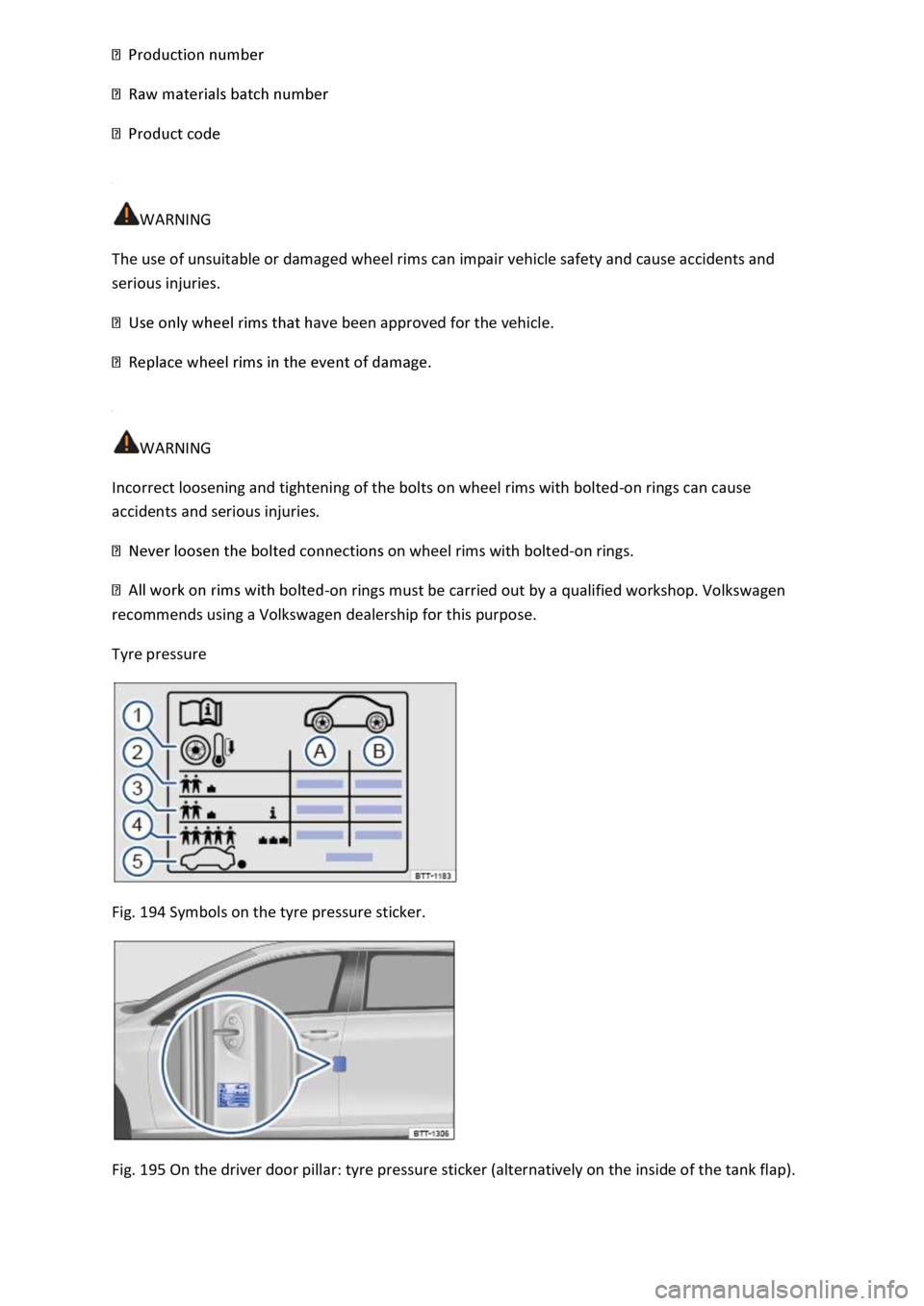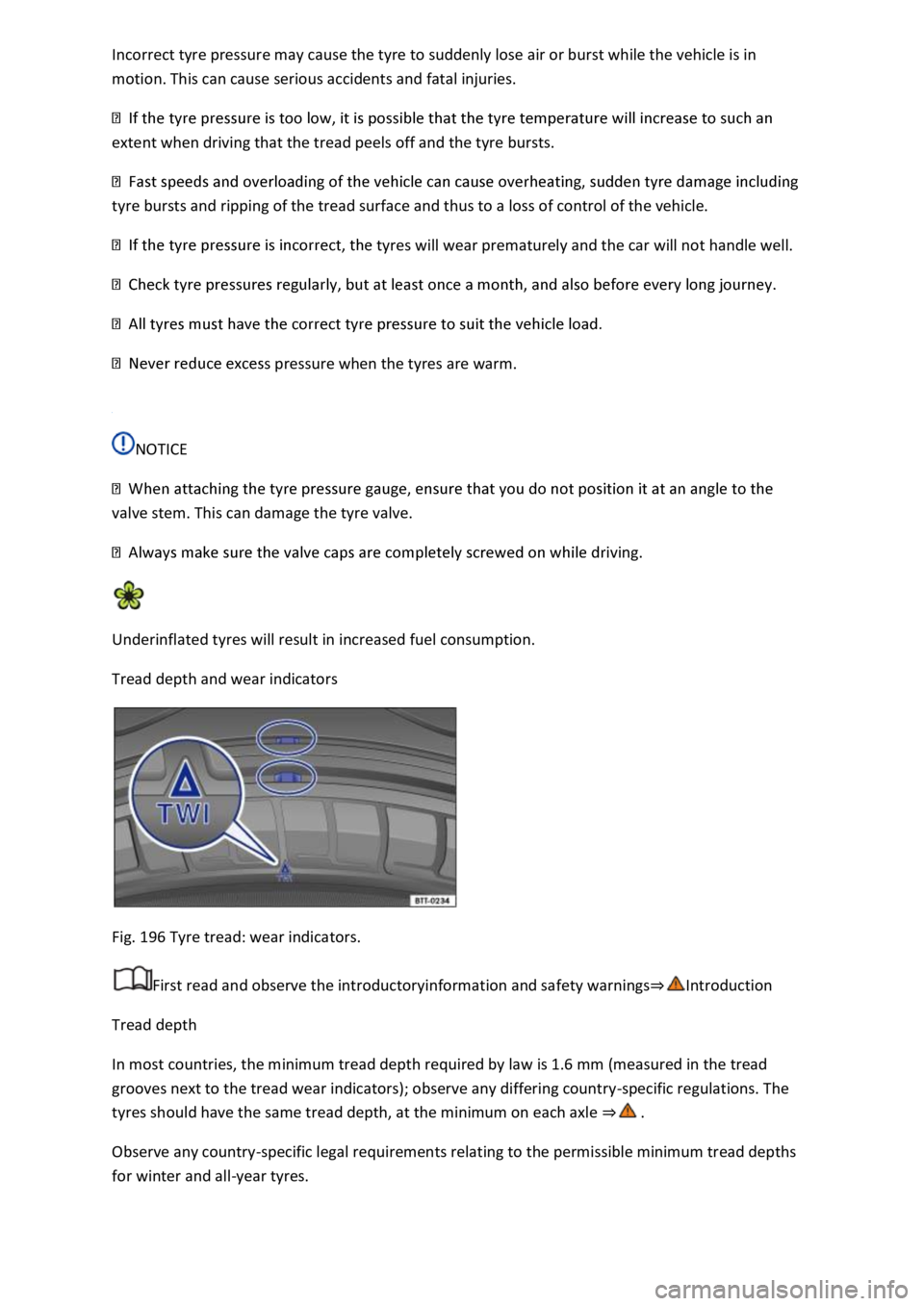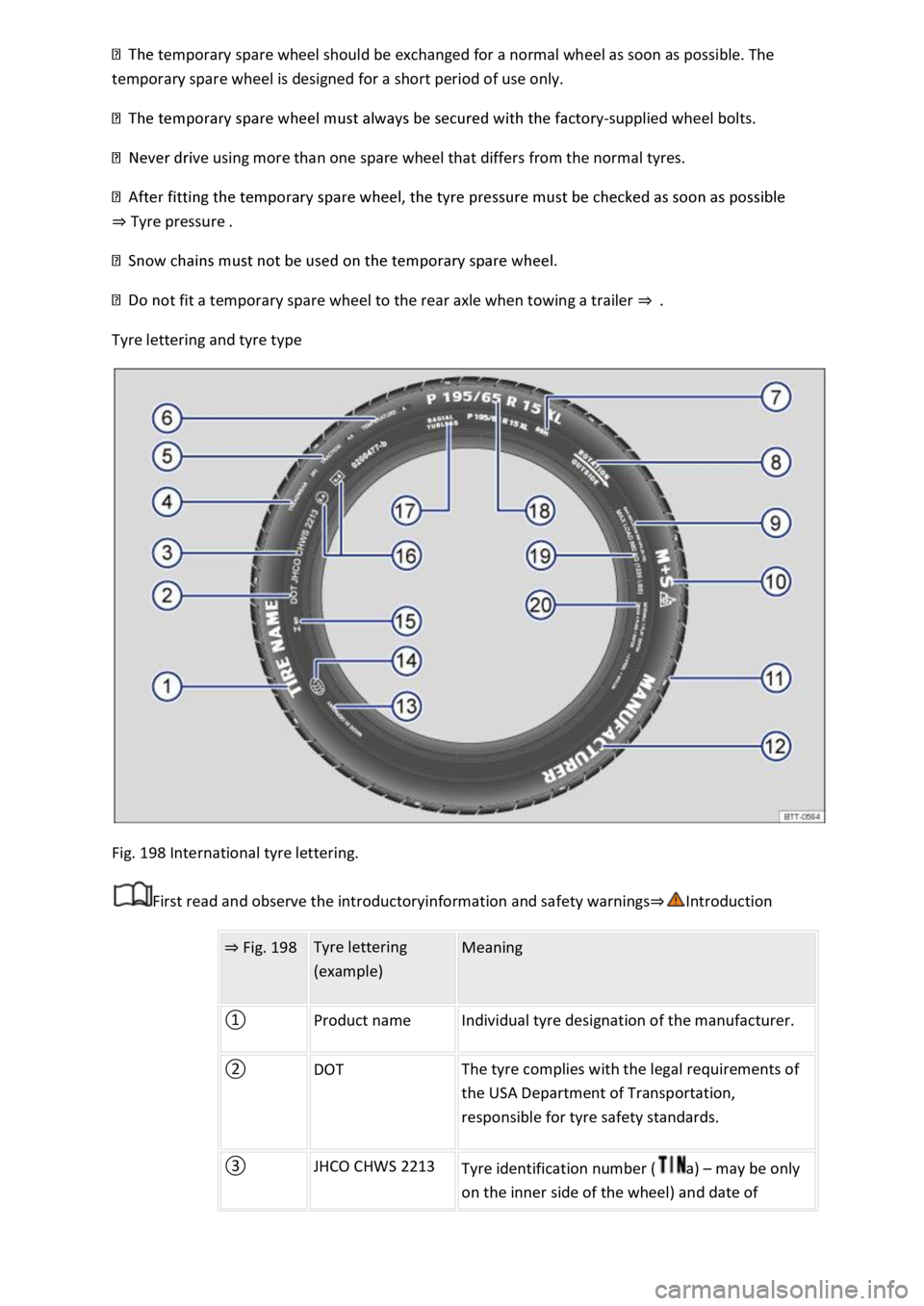tyre pressure VOLKSWAGEN T-ROC 2019 User Guide
[x] Cancel search | Manufacturer: VOLKSWAGEN, Model Year: 2019, Model line: T-ROC, Model: VOLKSWAGEN T-ROC 2019Pages: 502, PDF Size: 8.58 MB
Page 393 of 502

The Tyre Pressure Loss Indicator may react with a delay or not display anything at all in the event
of a sporty driving style, when driving on snow-covered or icy roads or unpaved roads or when
driving with snow chains.
Synchronising the Tyre Pressure Loss Indicator
button or function button, depending on version Vehicle settings menu
tem.
button.
After an extended driving time with driving at different speeds, the system will automatically learn
the new values and monitor them.
t to rear.
The Tyre Pressure Loss Indicator does not work if there is a fault in the ESC or ABS
Troubleshooting
After a warning about the tyre pressure being too low, switch the ignition off and then back on
again. The Tyre Pressure Loss Indicator can be re-synchronised only after this has been done.
Troubleshooting for Tyre Pressure Loss Indicator
First read and observe the introductoryinformation and safety warnings
lit up
Do not drive on!
s Tyre pressure
Page 394 of 502

synchronise the Tyre Pressure Loss Indicator Tyre Pressure Loss Indicator
flashes for 65 seconds and then remains lit continuously
Do not drive on!
-synchronise the Tyre Pressure Loss Indicator Tyre Pressure Loss Indicator
WARNING
Differing tyre pressures or tyre pressures that are too low can cause tyre damage, tyre failure, loss of
vehicle control, accidents, serious injury and death.
lights up, stop the vehicle as soon as possible and check all the tyres
Useful information about wheels and tyres
vehicle stability and increase the braking distance.
lead
to a tyre bursting and the loss of control over the vehicle.
recommended tyre pressure can be found on a sticker Tyre pressure
em cannot function correctly unless all cold tyres have the correct tyre
pressure.
Tyre pressure
Tyre pressure
warm up the tyre to such an extent that the tread may separate and the tyre could burst. This could
cause the driver to lose control of the vehicle.
the tyre bursts, leading you to lose control of the vehicle.
rely and the vehicle will not
handle well.
to the nearest qualified workshop and check and correct the tyre pressure Useful information
about wheels and tyres
Page 395 of 502

Tyre Pressure Loss Indicator. In the event of a malfunction, the indicator lamp will flash for 65
seconds and then light up continuously. However, the indicator lamp will go out when the road
conditions or driving style change.
Useful information about wheels and tyres
Introduction
This chapter contains information on the followingsubjects:
Handling wheels and tyres
Wheel rims and wheel bolts
Tyre pressure
Tread depth and wear indicators
Tyre damage
Spare wheel or temporary spare wheel
Tyre lettering and tyre type
Maximum load and speed range for tyres
Winter tyres
Snow chains
The tyres are the most heavily loaded and most underestimated parts of a vehicle. Tyres are very
important as the narrow tyre contact surfaces are the only contact between the vehicle and the
road.
The service life of tyres is dependent on tyre pressure, driving style, handling and correct fitting.
WARNING
New tyres or tyres which are old, worn down or damaged cannot provide full vehicle control and
braking efficiency.
injuries.
s must be fitted with radial tyres of the same type, size (rolling circumference) and
the same tread pattern.
particularly carefully for the first 600 km in order to prevent accidents and serious injury.
the tyre pressure is too low, it is possible that the tyre temperature will increase to such an extent
when driving that the tread peels off and the tyre bursts.
Page 398 of 502

lace tyres at least on an axle-by-axle basis
type.
-approved tyres.
Re-synchronising the Tyre Pressure Loss Indicator
The Tyre Pressure Loss Indicator must be re-synchronised each time one or more wheels is changed.
This also applies if the wheels have been swapped, e.g. from the front to the rear Tyre monitoring
system
WARNING
Aggressive liquids and other substances can cause visible and invisible damage to the tyres, which
can cause the tyre to burst.
from the tyres.
WARNING
Even if they have not been used, old tyres can suddenly lose pressure or burst, especially at high
speeds, and thus cause accidents and serious injuries.
ith
extra care at all times.
WARNING
New tyres must be run in as they initially have reduced grip and braking efficiency.
km in order to prevent accidents and serious injury.
WARNING
Wheels must have the necessary clearance. If the wheels do not have the necessary clearance, the
tyre could rub on parts of the running gear, vehicle body and the brake lines. This can lead to a fault
in the brake system and to tread separation and thus to a tyre bursting.
and must not rub on any vehicle body parts.
Page 400 of 502

WARNING
The use of unsuitable or damaged wheel rims can impair vehicle safety and cause accidents and
serious injuries.
ave been approved for the vehicle.
WARNING
Incorrect loosening and tightening of the bolts on wheel rims with bolted-on rings can cause
accidents and serious injuries.
on wheel rims with bolted-on rings.
-on rings must be carried out by a qualified workshop. Volkswagen
recommends using a Volkswagen dealership for this purpose.
Tyre pressure
Fig. 194 Symbols on the tyre pressure sticker.
Fig. 195 On the driver door pillar: tyre pressure sticker (alternatively on the inside of the tank flap).
Page 401 of 502

Information on the sticker Fig. 194
Tyre pressure for the tyres on the front axle.
Tyre pressure for the tyres on the rear axle.
Note: check the tyre pressure when the tyres are cold.
Tyre pressure for partial load.
Vehicle-dependent: comfort tyre pressure for partial load.
Tyre pressure for full load.
Tyre pressure level for the spare or temporary spare wheel.
The sticker provides the correct tyre pressure for approved tyres and is located either on the driver
door pillar Fig. 195or inside the tank flap.
The appearance of the sticker may differ between vehicles. It may include additional tyre sizes.
The wrong tyre pressure will have a negative effect on the vehicle handling and leads to high levels
of wear or even a burst tyre at high speeds.
Comfort tyre pressure
Depending on the vehicle, the tyre pressure sticker may show details of a comfort tyre pressure
Fig.
0
increase when driving with comfort tyre pressure.
Checking the tyre pressure
tyres. Tyre pressure is always higher in warm tyres than it is in cold tyres. For this reason, never
reduce the pressure in warm tyres to adjust the tyre pressure.
Fig.
0
and observe the
information on the tyre monitoring system.
which is given on the sidewall of the tyre.
WARNING
Page 402 of 502

suddenly lose air or burst while the vehicle is in
motion. This can cause serious accidents and fatal injuries.
extent when driving that the tread peels off and the tyre bursts.
tyre bursts and ripping of the tread surface and thus to a loss of control of the vehicle.
tyres will wear prematurely and the car will not handle well.
s pressure when the tyres are warm.
NOTICE
valve stem. This can damage the tyre valve.
iving.
Underinflated tyres will result in increased fuel consumption.
Tread depth and wear indicators
Fig. 196 Tyre tread: wear indicators.
First read and observe the introductoryinformation and safety warnings
Tread depth
In most countries, the minimum tread depth required by law is 1.6 mm (measured in the tread
grooves next to the tread wear indicators); observe any differing country-specific regulations. The
tyres should have the same tread depth, at the minimum on each axle
Observe any country-specific legal requirements relating to the permissible minimum tread depths
for winter and all-year tyres.
Page 405 of 502

r remove the luggage compartment floor Luggage compartment floor
centre hole in the rim is positioned exactly above the hole or threaded pin.
overing in the luggage compartment if necessary.
Luggage compartment floor
If the spare wheel tyre is not the same as the tyres on the vehicle
If the spare wheel tyre differs from the other tyres on the vehicle, the spare wheel must be used
only in the event of a tyre failure and for a short time
Observe these driving notes:
km/h (50 mph).
not use snow chains on the temporary spare wheel Snow chains
spare wheel Tyre pressure
WARNING
Incorrect use of the spare wheel or temporary spare wheel can lead to a loss of control over the
vehicle, collisions or other accidents and cause serious injuries.
wear indicators.
ped with a temporary spare wheel instead of a spare wheel. The
temporary spare wheel can be recognised by a sticker and the text 80 km/h or 50 mph. This is the
maximum speed at which you are permitted to drive with this tyre. The sticker must not be covered
during use of the wheel.
km/h (50 mph. Do not accelerate quickly, brake suddenly or drive at
high speed through bends.
km with a temporary spare wheel if it is fitted to the drive axle.
Page 406 of 502

temporary spare wheel should be exchanged for a normal wheel as soon as possible. The
temporary spare wheel is designed for a short period of use only.
-supplied wheel bolts.
ve using more than one spare wheel that differs from the normal tyres.
Tyre pressure
ot fit a temporary spare wheel to the rear axle when towing a trailer
Tyre lettering and tyre type
Fig. 198 International tyre lettering.
First read and observe the introductoryinformation and safety warnings
Fig. 198 Tyre lettering
(example)
Meaning
Product name Individual tyre designation of the manufacturer.
DOT The tyre complies with the legal requirements of
the USA Department of Transportation,
responsible for tyre safety standards.
JHCO CHWS 2213 Tyre identification number (a) may be only
on the inner side of the wheel) and date of
Page 411 of 502

peed index
Speed limitation
Winter tyres have a speed limit depending on the speed index Tyre lettering and tyre type
Speed warning settings can be made and adjusted in the Infotainment system using the
button and the and Tyres function buttons.
If you use V-rated winter tyres, the speed limits and required tyre pressure are determined by the
engine size. In this case, always ask a Volkswagen dealership about the maximum permitted speed
and required tyre pressure.
All-wheel drive (4MOTION)
Thanks to its all-wheel drive, the vehicle has good traction in winter conditions, even with the
standard tyres. Nevertheless, Volkswagen still recommends that winter tyres or all-year tyres should
be fitted on all four wheels in winter, above all because this will give improved braking efficiency.
Observe information on snow chainsSnow chains
WARNING
The improved driving characteristics afforded by the winter tyres in winter conditions should not
encourage you to take any risks.
driving style to suit visibility, weather, road and traffic conditions.
The vehicle handling is better if summer tyres are fitted at temperatures above +7